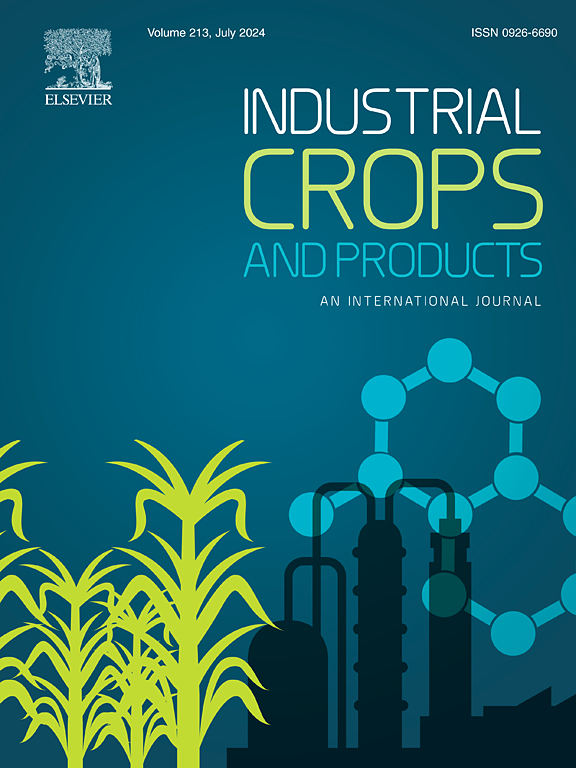Physicochemical characterization of Orychophragmus violaceus seeds and oil, a potential source of dihydroxy-fatty acids
IF 5.6
1区 农林科学
Q1 AGRICULTURAL ENGINEERING
引用次数: 0
Abstract
Seed oils are an attractive feedstock for sourcing biobased materials. Oils containing hydroxy fatty acids (HFAs) are of particular interest due to their unique properties and chemical utility. Orychophragmus violaceus (Ov) contains two unique dihydroxy fatty acids, making it a potential source of HFAs. In this study, we thoroughly investigated the properties of Ov seeds and its oil. Ov seeds had a thousand seed weight of 3.1 g, bulk density of 591 g L−1, and true density of 1144 g L−1. The seeds had a high oil content of 42.2 wt% and crude protein and carbohydrate contents of 23.8 and 25.2 wt%, respectively. Different oil extraction methods were evaluated, and cold pressing followed by hexane extraction of the press cake yielded the highest amount of HFAs. The Ov oil contained 50.5 wt% of diunsaturated HFA wuhanic acid and 9.9 wt% of monounsaturated nebraskanic acid. The thermal properties of Ov oil were sufficient for use in industrial applications, with a pour point of −18 °C and an oxidation onset of 182.8 °C. The Td95 of the oil under nitrogen atmosphere was 314.2 °C. The oil exhibited superb lubricant properties as determined by high frequency reciprocating rig (HFRR), with lower average wear scars and coefficient of frictions when compared to the petroleum-based lubricant PAO-6. Analysis of the glucosinolate content of the defatted seed meal indicated that it contained a high epiprogoitrin content of 69.80 µM g−1. Other relevant oil properties were measured and compared to castor and lesquerella oils, two other HFA-containing oils. The high oil content and advantageous properties of the seed oil make Ov a strong candidate for domestication as an industrial oil seed crop.

二羟基脂肪酸的潜在来源——堇菜籽及其油的理化性质
种子油是一种有吸引力的原料采购生物基材料。含有羟基脂肪酸(hfa)的油因其独特的性质和化学用途而受到特别关注。堇菜(Ov)含有两种独特的二羟基脂肪酸,使其成为HFAs的潜在来源。在这项研究中,我们深入研究了番石榴籽及其油的性质。Ov种子千粒重3.1 g,容重591 g L−1,真密度1144 g L−1。种子含油量为42.2% wt%,粗蛋白质和粗碳水化合物含量分别为23.8%和25.2% wt%。对不同的榨油方法进行了评价,结果表明,压榨饼采用冷压法,然后采用己烷法提取,得到的hfa含量最高。Ov油含有50.5 wt%的二不饱和HFA武汉酸和9.9 wt%的单不饱和内布拉斯酸。Ov油的热性能足以用于工业应用,其倾点为- 18°C,氧化起始温度为182.8°C。氮气气氛下原油的Td95为314.2℃。通过高频往复钻机(HFRR)测试,该润滑油表现出优异的润滑性能,与石油基润滑油PAO-6相比,其平均磨损痕和摩擦系数更低。对脱脂种子粕的硫代葡萄糖苷含量分析表明,其表原甲状腺素含量高达69.80 µM g−1。测量了其他相关油的性质,并与另外两种含hfa的蓖麻油和lesquerella油进行了比较。种子油的高含油量和优越的特性使其成为驯化作为工业油料作物的有力候选者。
本文章由计算机程序翻译,如有差异,请以英文原文为准。
求助全文
约1分钟内获得全文
求助全文
来源期刊

Industrial Crops and Products
农林科学-农业工程
CiteScore
9.50
自引率
8.50%
发文量
1518
审稿时长
43 days
期刊介绍:
Industrial Crops and Products is an International Journal publishing academic and industrial research on industrial (defined as non-food/non-feed) crops and products. Papers concern both crop-oriented and bio-based materials from crops-oriented research, and should be of interest to an international audience, hypothesis driven, and where comparisons are made statistics performed.
 求助内容:
求助内容: 应助结果提醒方式:
应助结果提醒方式:


